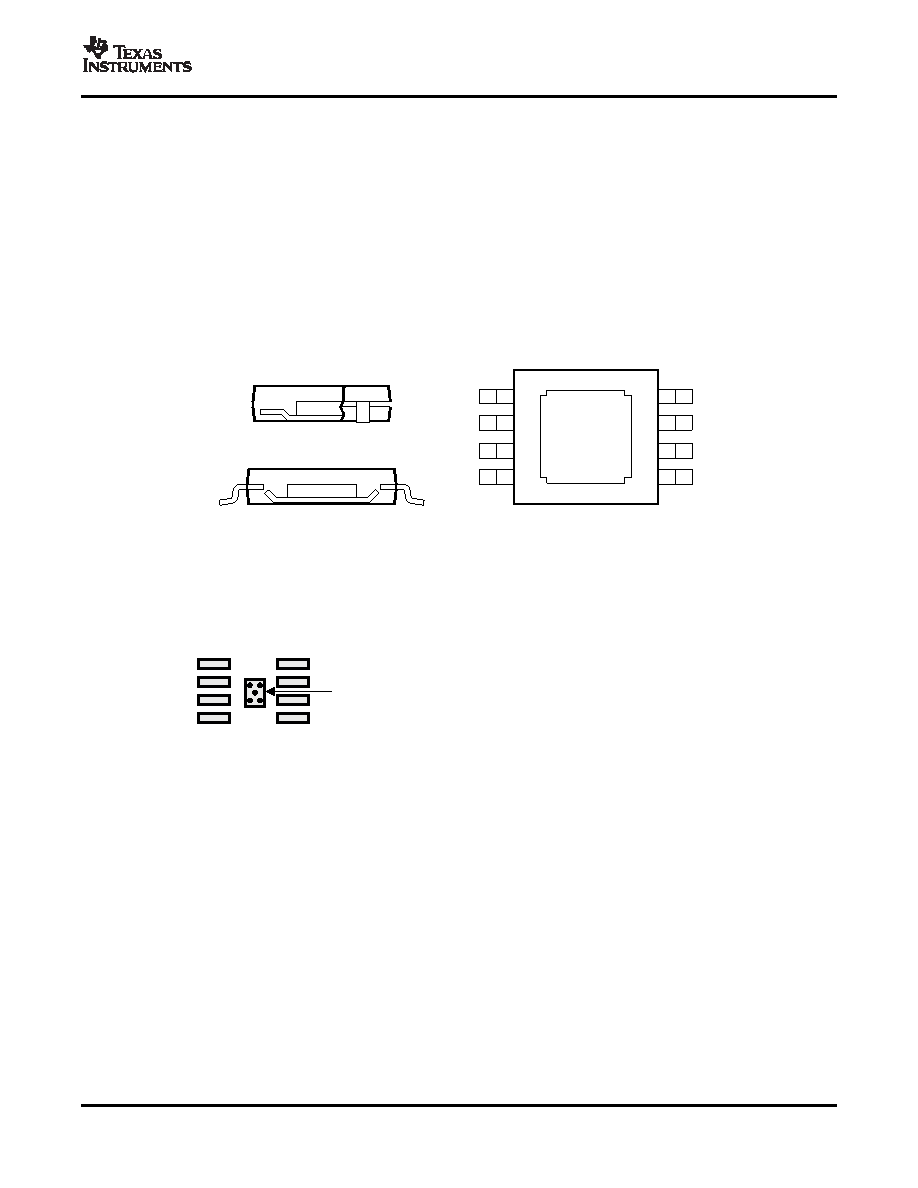- 您現(xiàn)在的位置:買(mǎi)賣(mài)IC網(wǎng) > PDF目錄98224 > THS4022CDRG4 (TEXAS INSTRUMENTS INC) 2 CHANNEL, VIDEO AMPLIFIER, PDSO8 PDF資料下載
參數(shù)資料
| 型號(hào): | THS4022CDRG4 |
| 廠商: | TEXAS INSTRUMENTS INC |
| 元件分類(lèi): | 音頻/視頻放大 |
| 英文描述: | 2 CHANNEL, VIDEO AMPLIFIER, PDSO8 |
| 封裝: | PLASTIC, MS-012AA, SOIC-8 |
| 文件頁(yè)數(shù): | 7/28頁(yè) |
| 文件大小: | 922K |
| 代理商: | THS4022CDRG4 |
第1頁(yè)第2頁(yè)第3頁(yè)第4頁(yè)第5頁(yè)第6頁(yè)當(dāng)前第7頁(yè)第8頁(yè)第9頁(yè)第10頁(yè)第11頁(yè)第12頁(yè)第13頁(yè)第14頁(yè)第15頁(yè)第16頁(yè)第17頁(yè)第18頁(yè)第19頁(yè)第20頁(yè)第21頁(yè)第22頁(yè)第23頁(yè)第24頁(yè)第25頁(yè)第26頁(yè)第27頁(yè)第28頁(yè)

www.ti.com
General Thermal Pad Design Considerations
DIE
SideView(a)
EndView(b)
BottomView(c)
DIE
Thermal
Pad
M0031-01
Thermalpadarea=68mils
70mils(1.73mm 1.78mm)with5vias.
Viadiameter=13mils(0.33mm).
M0032-02
SLOS265C – SEPTEMBER 1999 – REVISED JULY 2007
The THS402x is available packaged in a thermally-enhanced DGN package, which is a member of the
PowerPAD family of packages. This package is constructed using a downset leadframe upon which the die is
mounted [see Figure 37(a) and Figure 37(b)]. This arrangement results in the lead frame being exposed as a
thermal pad on the underside of the package [see Figure 37(c)]. Because this thermal pad has direct thermal
contact with the die, excellent thermal performance can be achieved by providing a good thermal path away from
the thermal pad.
The PowerPAD package allows for both assembly and thermal management in one manufacturing operation.
During the surface-mount solder operation (when the leads are being soldered), the thermal pad can also be
soldered to a copper area underneath the package. Through the use of thermal paths within this copper area,
heat can be conducted away from the package into either a ground plane or other heat dissipating device.
The PowerPAD package represents a design breakthrough, combining the small area and ease of the surface
mount assembly method to eliminate the previously difficult mechanical methods of heatsinking.
NOTE: The thermal pad is electrically isolated from all terminals in the package.
Figure 37. Views of Thermally Enhanced DGN Package
Although there are many ways to heatsink this device properly, the following steps illustrate the recommended
approach.
Figure 38. Thermal Pad PCB Etch and Via Pattern
1. Prepare the PCB with a top side etch pattern as shown in Figure 38. There should be etch for the leads as
well as etch for the thermal pad.
2. Place five holes in the area of the thermal pad. These holes should be 13 mils (0.33 mm) in diameter. Keep
them small so that solder wicking through the holes is not a problem during reflow.
3. Additional vias may be placed anywhere along the thermal plane outside of the thermal pad area. These vias
help dissipate the heat generated by the THS402xDGN IC. These additional vias may be larger than the
13-mil (0.33-mm) diameter vias directly under the thermal pad. They can be larger because they are not in
the thermal pad area to be soldered, so wicking is not a problem.
4. Connect all holes to the internal ground plane.
5. When connecting these holes to the ground plane, do not use the typical web or spoke via connection
methodology. Web connections have a high thermal resistance connection that is useful for slowing the heat
transfer during soldering operations. This makes the soldering of vias that have plane connections easier. In
this application, however, low thermal resistance is desired for the most efficient heat transfer. Therefore, the
holes under the THS402xDGN package should connect to the internal ground plane with a complete
connection around the entire circumference of the plated-through hole.
6. The top-side solder mask should leave the terminals of the package and the thermal pad area with its five
holes exposed. The bottom-side solder mask should cover the five holes of the thermal pad area. This
prevents solder from being pulled away from the thermal pad area during the reflow process.
Copyright 1999–2007, Texas Instruments Incorporated
15
相關(guān)PDF資料 |
PDF描述 |
|---|---|
| THS4022IDRG4 | 2 CHANNEL, VIDEO AMPLIFIER, PDSO8 |
| THS4021CDRG4 | 1 CHANNEL, VIDEO AMPLIFIER, PDSO8 |
| THS4061IDGN | 1 CHANNEL, VIDEO AMPLIFIER, PDSO8 |
| THS4061MFK | 1 CHANNEL, VIDEO AMPLIFIER, CQCC20 |
| THS4062CDGNRG4 | 1 CHANNEL, VIDEO AMPLIFIER, PDSO8 |
相關(guān)代理商/技術(shù)參數(shù) |
參數(shù)描述 |
|---|---|
| THS4022D | 制造商:TI 制造商全稱(chēng):Texas Instruments 功能描述:350-MHz LOW-NOISE HIGH-SPEED AMPLIFIERS |
| THS4022DGN | 制造商:TI 制造商全稱(chēng):Texas Instruments 功能描述:350-MHz LOW-NOISE HIGH-SPEED AMPLIFIERS |
| THS4022EVM | 功能描述:放大器 IC 開(kāi)發(fā)工具 THS4022 Hi-Spd Amp Eval Mod RoHS:否 制造商:International Rectifier 產(chǎn)品:Demonstration Boards 類(lèi)型:Power Amplifiers 工具用于評(píng)估:IR4302 工作電源電壓:13 V to 23 V |
| THS4022ID | 功能描述:高速運(yùn)算放大器 Dual 350MHz RoHS:否 制造商:Texas Instruments 通道數(shù)量:1 電壓增益 dB:116 dB 輸入補(bǔ)償電壓:0.5 mV 轉(zhuǎn)換速度:55 V/us 工作電源電壓:36 V 電源電流:7.5 mA 最大工作溫度:+ 85 C 安裝風(fēng)格:SMD/SMT 封裝 / 箱體:SOIC-8 封裝:Tube |
| THS4022IDG4 | 功能描述:高速運(yùn)算放大器 Dual 350MHz RoHS:否 制造商:Texas Instruments 通道數(shù)量:1 電壓增益 dB:116 dB 輸入補(bǔ)償電壓:0.5 mV 轉(zhuǎn)換速度:55 V/us 工作電源電壓:36 V 電源電流:7.5 mA 最大工作溫度:+ 85 C 安裝風(fēng)格:SMD/SMT 封裝 / 箱體:SOIC-8 封裝:Tube |
發(fā)布緊急采購(gòu),3分鐘左右您將得到回復(fù)。